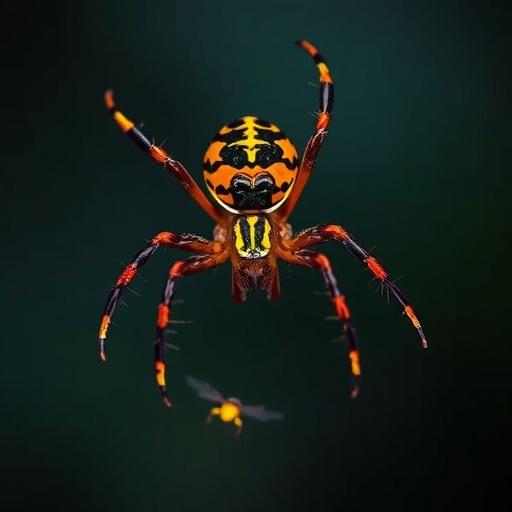In the dimly lit understory of Taiwan’s subtropical forests, a nocturnal hunter employs an extraordinary strategy to capture its prey. The sheet web spider, Psechrus clavis, has been observed exploiting the very signals used by fireflies for mating communication, turning these luminous beacons into tools for predation. This groundbreaking discovery, recently published in the Journal of Animal Ecology, unveils a rare example of a predator co-opting its prey’s bioluminescent mating signals to lure additional victims into its web.
Ecologists from Tunghai University have meticulously documented the unique behavior of Psechrus clavis, a species of sit-and-wait predator that constructs extensive sheet webs in the forest canopy. Unlike many predators that produce their own lures or actively hunt, these spiders capitalize on the captured fireflies’ continuous bioluminescence, leaving these glowing insects ensnared in the web for up to an hour. During this time, the immobilized fireflies continue to emit light, effectively acting as living, pulsating beacons that attract other unsuspecting prey.
This enigmatic observation prompted researchers to design a controlled field experiment to rigorously test whether the spiders intentionally use the fireflies’ glow to enhance hunting success. The team introduced LED lights replicating the wavelength and intensity of the firefly’s bioluminescent signal inside spider webs and compared prey capture rates with those caught using unadorned control webs. The results were striking: webs equipped with artificial firefly-like LEDs attracted three times more prey than control webs without such stimuli. When focusing specifically on the attraction and capture of fireflies, the number of prey increased by a remarkable factor of ten.
Such a significant increase in prey capture underscores the adaptive advantage that Psechrus clavis gains by hijacking the firefly’s mating signals. The research also revealed that the majority of trapped fireflies were males, which likely mistake the persistent glow for potential mates, inadvertently leading them into ecological traps. This phenomenon illustrates an intricate intersection of sexual signaling and predation, where communication intended for reproductive success is subverted into a fatal lure.
Dr. I-Min Tso, the lead investigator of this study, emphasized the novelty and ecological implications of this interaction. “Our research illuminates a previously undocumented strategy in which firefly bioluminescence, meant for sexual communication, also serves as a mechanism exploited by predators,” Dr. Tso explained. Such findings highlight the evolutionary arms race between predator and prey, demonstrating how sensory modalities like light emission can be turned against the signaler.
This system provides a compelling example of predator-prey coevolution, particularly in nocturnal environments where visual cues become paramount. Unlike anglerfish that invest significant metabolic resources to produce their own bioluminescent lures, the sheet web spiders appear to outsource this costly endeavor by repurposing the prey’s own signaling system. This strategy not only conserves energy but also leverages the prey’s natural behavior, creating a highly efficient mechanism of attraction without the metabolic burden.
The ecological niche of Psechrus clavis is tightly linked to its primary prey, the winter firefly Diaphanes lampyroides, a species notable for its continuous, non-flashing bioluminescent glow used to attract mates. The spiders’ webs, thereby, become bioluminescent mosaics as captured fireflies remain trapped and illuminated, serving as inadvertent advertising posts. Video recordings from the study reveal fascinating predatory tactics: while moths caught in the webs are consumed immediately, captured fireflies are left undisturbed for prolonged periods. This differential handling strongly suggests that the spiders are capable of distinguishing between prey types, likely using bioluminescent cues to optimize their feeding behavior.
This sensory discrimination highlights the sophistication of predatory behavior in these spiders. By potentially recognizing firefly-specific luminescent signals, Psechrus clavis delays consumption to maximize the utility of the captured prey’s signal in attracting additional fireflies. Such plasticity in prey handling underscores complex cognitive or sensory processing abilities previously underappreciated in arachnid predation strategies.
The fieldwork, conducted within the conifer plantations of National Taiwan University’s Xitou Nature Educational Area, combined careful observational studies with innovative experimental designs. Despite the promising results, the research team acknowledges limitations in the mimicking technology. While the LED lights closely replicated the wavelength and intensity of firefly bioluminescent signals, real fireflies would provide more accurate results. However, logistical and ethical constraints make the use of live fireflies in such experiments exceedingly difficult.
This research not only deepens our understanding of predator-prey dynamics and sensory ecology but also challenges traditional perspectives on bioluminescent communication. It reveals an unexpected dimension of ecological complexity, where the evolution of signals is shaped not only by intersexual selection but also by predator interception. The findings open avenues for exploring similar interactions across other taxa and environments, potentially reshaping our grasp of nocturnal ecosystem functioning.
Moreover, this study serves as a stark reminder of the nuanced interdependence within natural communities. Fireflies that rely on bioluminescence for reproduction unwittingly provide a resource for predators, illuminating the costs and trade-offs embedded within evolutionary communication strategies. As nocturnal signaling systems evolve, they face the dual pressures of attracting mates and avoiding predator eavesdropping, a delicate balance reflected in the striking behavior of Psechrus clavis.
In summary, the collaboration between predator and prey in this bioluminescent dance illustrates a remarkable case of evolutionary innovation. By leveraging the prey’s own signals, the sheet web spider transcends metabolic constraints and refines its hunting strategy, contributing to a fascinating chapter in the story of ecological interactions. Future investigations using advanced sensory technologies and behavioral assays hold promise for unraveling the finer mechanisms driving this predation phenomenon.
Subject of Research: Animals
Article Title: (Not provided)
Web References: http://dx.doi.org/10.1111/1365-2656.70102
References: Journal of Animal Ecology, DOI: 10.1111/1365-2656.70102
Image Credits: Tunghai University Spider
Keywords: Behavioral ecology, Predation, Ethology




